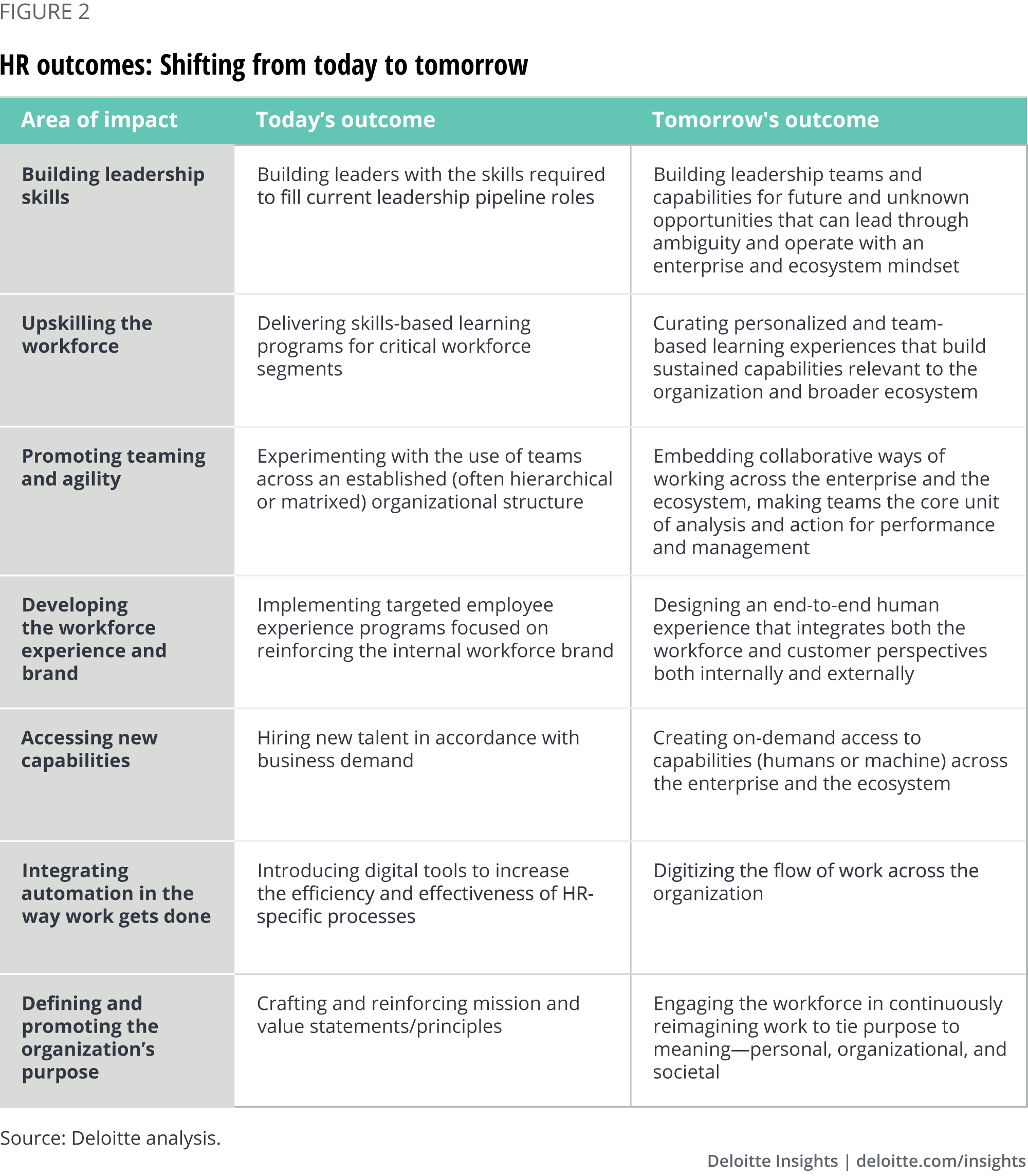
A memo to HR Expand focus and extend influence
The future of HR must be one of expanded focus and extended influence: expanding its focus to encompass the entirety of work and the workforce, and extending its sphere of influence to the enterprise and business ecosystem as a whole.
2021 Global Human Capital Trends
Sign up to receive a copy of our new approach to Trends launching this winter
Dear HR,
Out of all the chapters we drafted this year, we were most excited and, frankly, most nervous about this one. Over the past decade of our Global Human Capital Trends report, we have been prolific in our writing about HR. In fact, in looking back, we have written at least 13 distinct chapters on the topic, not including the calls to action for HR that we have embedded elsewhere. Our passion for this topic has resulted in us using words ranging from “transformation” to “reinvention” and even “revolution” as we started to ponder the impact that digital technologies could have on the function. But fundamentally, our consistent focus has been on what HR needed to do to meet the evolving needs of the business—recognizing that HR has always been more than a back-office function, but rather a core piece of the organizational fabric, one with the ability to influence the most powerful asset of any organization: its people.
Learn more
Explore the Human Capital Trends collection
Watch the video
Learn about Deloitte's services
Order a copy of Work Disrupted, Deloitte's new book on the accelerated future of work
Explore 5 lessons from the pandemic for the future of work
Go straight to smart. Get the Deloitte Insights app
After 10 years of dialogue on this topic, it’s fair to ask: Did it make a difference? Thankfully, the answer is yes. Sixty-five percent of our respondents in our 2020 global survey reported that HR has made progress over the past decade, but we knew we couldn’t stop there. Because despite the progress made, our respondents this year reported a 64-point gap between importance and readiness, with 75 percent saying the evolving role of HR was important or very important for their success over the next 12 to 18 months, but only 11 percent saying they were very ready to address this trend.
That finding leads us to a fundamental question: Given the growing importance of the human element at work and the continued gap in HR readiness, will HR remain as a distinct function, or has 10 years of progress been overshadowed by a persistent view that HR may never get there, signaling the end of HR as we know it?
The data from our survey provided a two-dimensional answer. While 93 percent of our respondents believe that HR will remain a distinct function over the next five years, a majority (55 percent) also believe that HR will substantially or radically change within the next 12 to 18 months, with no noticeable difference in these views between HR and non-HR respondents. There is no doubt that change is coming, but we believe it needs to be more than transformation or reinvention or even revolution—it needs to be foundational, and that is where the real story begins.
As we look back over those 13 past chapters and the recommendations within them, they have been based on three fundamental assumptions:
- Work outcomes are stable (organizations know what they need to do and how to do it)
- Jobs are predictable (composed of fixed, task-based work)
- People are fungible (mechanized work enables most humans to do most jobs)
But these are no longer the assumptions in which we can ground HR, because in the future of work, they no longer hold. The false notion that work and workers are mechanistic, interchangeable parts on an assembly line has reinforced the preoccupation with automation—replacing workers with machines—and underplayed the opportunity to focus on how work can be reimagined and how workers can be engaged in teams as participants and innovators. The mechanistic view, pioneered by Frederick Taylor in his theories of scientific management,1 has been superseded over the past 100 years by the acknowledgment that worker motivation can enhance productivity, and it has been even further debunked as social, political, and technological influences have put the human element at work front and center.
As business strategies evolve in the face of disruption and organizations come face to face with the realization that productivity has been flat and in decline for the past two decades,2 organizations are being challenged to rethink outdated views and establish a new set of truths for the social enterprise at work:
- Beyond focusing on how to improve the way work is done today, organizations now need to first consider what work they should be doing tomorrow, putting work outcomes in a constant state of flux and work in a continuous state of reimagination.
- As a result of work becoming less mechanistic and work outcomes evolving, jobs have become increasingly fluid and dynamic, with some thought leaders believing that the end of jobs—fixed, task-based work—is near. This change is being accelerated as ways of working shift away from rigid reporting lines to networks of teams, from prescribed routines and job descriptions to expanded job canvases, and from narrow skills to broad capabilities.
- The potential implication for humans is that they need to be viewed not as interchangeable cogs in an organization, but rather as individuals with unique and disparate experiences, thoughts, attitudes, needs, and, ultimately, value—all of which makes the management of the human element at work more important and complex than ever before.
As these truths change, so does the foundation upon which HR needs to be based. In the new world of work, the foundation for HR needs to be one of expanded focus and extended influence—two concepts that we explain in further detail below.

The good news is that our respondents recognize this shift. Out of the 55 percent of our respondents who indicated that HR will change substantially or radically over the next 12 to 18 months, an overwhelming majority—75 percent—thought that change would be an expansion of HR’s accountability. This expansion needs to be centered on two distinct dimensions: scope of influence and areas of focus (figure 1). Similar to the evolution of traditional business enterprises to social enterprises, HR also needs to extend its scope of influence beyond the traditional lines of the function to the enterprise and ecosystem as a whole, and it needs to broaden its focus from employees to the organization and, ultimately, to the work and workforce itself. We call this shift “exponential HR.”
What does this expansion look like in action? Many areas of opportunity and impact exist, but to start the discussion, we examine the top areas where our 2020 survey respondents indicated that HR could make the greatest impact. The evolution of these outcomes is summarized in figure 2.

Like any shift, this one will require some significant changes. When our survey respondents identified the biggest changes HR should make to maximize its impact, four rose to the top of the list:
- Increase new capabilities (47 percent). We see HR organizations doing this by adopting a new mindset: Embracing new traits and behaviors that can help allow the enterprise to thrive in the digital age.
- Change the HR organization design to incorporate more agile and team-based work (45 percent). HR organizations can do this by applying a new lens: Adopting an operating model that enables HR to flex based on dynamic business needs.
- Increase the efficiency through which HR activities occur through automation (38 percent). HR organizations could do this by adopting enablers: Deploying advanced technology to promote productivity and value and simplify the experience.
- Expand the expectations and stature of HR leaders (24 percent). HR leaders can do this by elevating their focus: Driving tangible, measurable value across the enterprise.
Movement in this direction will require HR to address some key challenges. Our survey results this year point to two key barriers: the way in which HR is typically structured, and HR’s general lack of alignment with the areas where the biggest business impact can be made.
With respect to structure, the survey results identified some resistance. Despite clear signs that structural change may be required, a plurality of survey respondents (42 percent) believe that the structure of HR should remain aligned to HR functional areas. But in a world where alignment to work and the workforce is needed more than ever, traditional functional alignment is something that we believe should be reconsidered.
With regard to HR’s alignment with business impact, our survey respondents identified some critical gaps. While developing leaders, upskilling the workforce, and promoting teaming were the top three areas where respondents thought HR could make the greatest impact, two of these three areas—leadership and teaming—scored the lowest in terms of respondents’ perceived readiness. Based on these findings, we believe that organizations should take a more in-depth look at the prioritization of HR’s work and effort.
Despite these barriers, the shift to exponential HR is underway in a number of organizations. Alexion Pharmaceuticals, for instance, capped off a three-year organizational transformation by bringing its HR, IT, and patient advocacy organizations together into one new human experience function.3 This new function reflects Alexion’s belief that you cannot talk about the employee experience without understanding how that experience impacts patients, representing a shift in the way that this organization thinks about the outcomes of their work. Similarly, a leading global health care company decided to move to a more holistic and inclusive framework to talent, including internal and external talent. In very close collaboration with IT and procurement, this framework will now sit under the people & culture function, enabling stronger knowledge of the capabilities and enhanced access to this talent pool for strategic workforce planning purposes. By having the people & culture function cocreating, with colleagues from IT and procurement, the processes, practices and the choice of technology solutions, they will ensure consistency in the experience for their entire workforce, with a strong focus on the moments that matter. This will also allow them to offer the right solutions for a specific business need, regardless if the best talent solution is to buy, build, borrow, or bridge.4 And Highmark Health’s HR has responded to the greater fluidity and unpredictability of jobs by creating a new organization called thinkUP, which partners across the enterprise and ecosystem to reimagine the way in which work gets done and the roles that are needed to execute that work on a real-time basis. This process includes everything from organization and process design to the use of advanced technologies, automation, and econometrics.5
We are also seeing some signs of what happens when this shift does not occur. At several large companies, the CHRO position has been eliminated and HR teams have been moved under other C-suite or divisional leaders. These examples reinforce that HR is at an important inflection point. While our survey respondents generally agree there is a great opportunity ahead, they also acknowledge that there are doubts about HR’s ability to capitalize on it. Twenty-six percent of our non-HR respondents reported that they are not confident in HR’s ability to make the needed changes, and an additional 37 percent said they were only somewhat confident. Even respondents who were HR professionals themselves expressed a level of doubt: Only 13 percent of those respondents reported being very confident that the shifts were feasible.
In the coming decade, HR has the opportunity to embrace the future, expand its reach and focus, and assume the leading role at the vanguard of work, the workplace, and the workforce on behalf of the enterprise. In this expanded role, HR becomes a vital enabler of an organization’s ability to thrive in a world where the old rules of work no longer apply, and the new ones are evolving rapidly. Exponential HR, focused on humanizing the world of work, is a key source of strength for the future-focused organization seeking to make the most of human capital in today’s dynamic environment.
© 2021. See Terms of Use for more information.
Explore the collection
-
The postgenerational workforce Article4 years ago
-
Superteams Article4 years ago
-
Knowledge management Article4 years ago
-
Beyond reskilling Article4 years ago
-
The compensation conundrum Article4 years ago
-
Governing workforce strategies Article4 years ago























